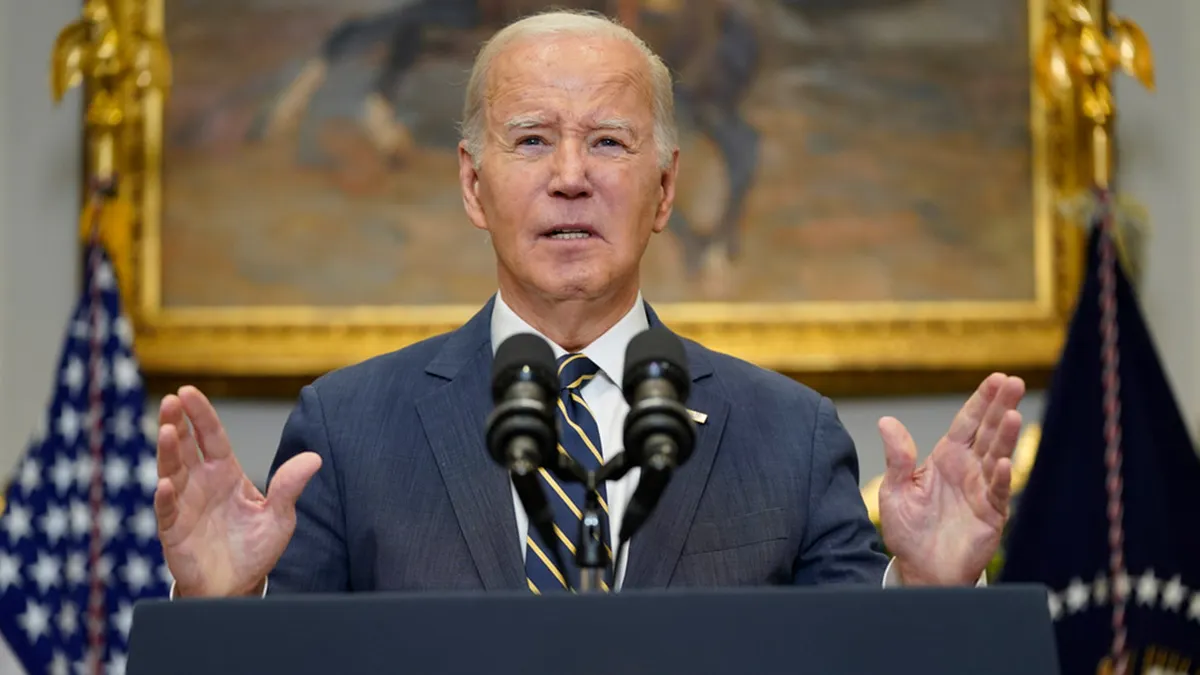
A new book by political historians John B. Judis and Ruy Teixeira warns the Democrats they’re losing a critical voting base — working-class minorities.
Two decades ago, Judis and Teixeira published a book claiming ‘The Emerging Democratic Majority’ consisted of the working-class, minorities, young people, women and educated professionals.
But in their new book, ‘Where Have All the Democrats Gone?: The Soul of the Party in the Age of Extremes,’ Judis and Teixeira argue Democrats ‘have steadily lost the allegiance of ‘everyday Americans’ — the working- and middle-class voters that were at the core of the older New Deal coalition.’
‘Initially, most of these voters were white, but in the last elections, Democrats have also begun to lose support among Latino and Asian working-class voters as well,’ they wrote.
‘Democrats continued to enjoy huge margins among black voters, but even here, those margins declined in 2020 by 5 points relative to 2016,’ they continued. ‘In 2022, Democrats lost more ground among black voters, compounding their losses from 2020.’
Part of the reason, they argued, is the changing political landscape in the era of former President Donald Trump, as well as the left’s embrace of what conservatives would describe as woke politics.
‘What began happening in the last decade is a defection, pure and simple, of working-class voters,’ they wrote. ‘That’s something that we really didn’t anticipate when we wrote ‘The Emerging Democratic Majority.’ The loss of working-class voters, who constitute the great majority of the electorate, could undermine Democrats’ chances not simply of being the majority party but of being competitive with the Republican Party.
‘Democrats, we believe, need to look in the mirror and examine the extent to which their own failures contributed to the rise of the most toxic tendencies on the political right.’
Judis and Teixeira expanded on the Democratic Party’s losses among non-white, working-class Americans in a recent interview with Time magazine.
Teixeira argued that Trump found a way to exploit the Democrats’ weaknesses in a way that is still benefiting him in the 2024 presidential election, where he remains the commanding frontrunner.
‘But another transition point then hits in 2020,’ Teixeira said. ‘And that had been building for a while, which is the defection of non-white working-class voters for the Democratic Party.
‘We can see in the polling data that’s been collected in the last year or two that the weaknesses of Democrats among non-white voters, particularly Hispanic and Black working-class voters, is pretty significant,’ Teixeira continued.
‘They’re sort of realizing this is a problem. On the other hand, they’re so invested in this whole vector of cultural issues. They’re worried about the blowback on social media and from the college-educated ‘liberalish’ voters who are increasingly a loyal base of the Democratic Party.
‘Trump understood that, and he played upon it. He continues to play upon it. He continues to get votes upon it. And the Democrats are oblivious to it.’
Judis and Teixeira aren’t the only ones sounding the alarm about troubles facing the Democratic Party.
Sen. Bernie Sanders, I-Vt., gave a speech at Saint Anselm College in August urging Democrats to focus on economic issues or risk losing the 2024 election.
‘It should be deeply worrying that, according to recent polls, Democrats are losing support within the Latino communities and even among African American men,’ he said. ‘That has got to change, not just for the well-being of the Democratic Party, but for the future of our country.’
A Times/Siena Poll conducted in July showed Biden leading Trump by only 16 points among non-white, non-college educated voters.

A new book by political historians John B. Judis and Ruy Teixeira warns the Democrats they’re losing a critical voting base — working-class minorities.
Two decades ago, Judis and Teixeira published a book claiming ‘The Emerging Democratic Majority’ consisted of the working-class, minorities, young people, women and educated professionals.
But in their new book, ‘Where Have All the Democrats Gone?: The Soul of the Party in the Age of Extremes,’ Judis and Teixeira argue Democrats ‘have steadily lost the allegiance of ‘everyday Americans’ — the working- and middle-class voters that were at the core of the older New Deal coalition.’
‘Initially, most of these voters were white, but in the last elections, Democrats have also begun to lose support among Latino and Asian working-class voters as well,’ they wrote.
‘Democrats continued to enjoy huge margins among black voters, but even here, those margins declined in 2020 by 5 points relative to 2016,’ they continued. ‘In 2022, Democrats lost more ground among black voters, compounding their losses from 2020.’
Part of the reason, they argued, is the changing political landscape in the era of former President Donald Trump, as well as the left’s embrace of what conservatives would describe as woke politics.
‘What began happening in the last decade is a defection, pure and simple, of working-class voters,’ they wrote. ‘That’s something that we really didn’t anticipate when we wrote ‘The Emerging Democratic Majority.’ The loss of working-class voters, who constitute the great majority of the electorate, could undermine Democrats’ chances not simply of being the majority party but of being competitive with the Republican Party.
‘Democrats, we believe, need to look in the mirror and examine the extent to which their own failures contributed to the rise of the most toxic tendencies on the political right.’
Judis and Teixeira expanded on the Democratic Party’s losses among non-white, working-class Americans in a recent interview with Time magazine.
Teixeira argued that Trump found a way to exploit the Democrats’ weaknesses in a way that is still benefiting him in the 2024 presidential election, where he remains the commanding frontrunner.
‘But another transition point then hits in 2020,’ Teixeira said. ‘And that had been building for a while, which is the defection of non-white working-class voters for the Democratic Party.
‘We can see in the polling data that’s been collected in the last year or two that the weaknesses of Democrats among non-white voters, particularly Hispanic and Black working-class voters, is pretty significant,’ Teixeira continued.
‘They’re sort of realizing this is a problem. On the other hand, they’re so invested in this whole vector of cultural issues. They’re worried about the blowback on social media and from the college-educated ‘liberalish’ voters who are increasingly a loyal base of the Democratic Party.
‘Trump understood that, and he played upon it. He continues to play upon it. He continues to get votes upon it. And the Democrats are oblivious to it.’
Judis and Teixeira aren’t the only ones sounding the alarm about troubles facing the Democratic Party.
Sen. Bernie Sanders, I-Vt., gave a speech at Saint Anselm College in August urging Democrats to focus on economic issues or risk losing the 2024 election.
‘It should be deeply worrying that, according to recent polls, Democrats are losing support within the Latino communities and even among African American men,’ he said. ‘That has got to change, not just for the well-being of the Democratic Party, but for the future of our country.’
A Times/Siena Poll conducted in July showed Biden leading Trump by only 16 points among non-white, non-college educated voters.














